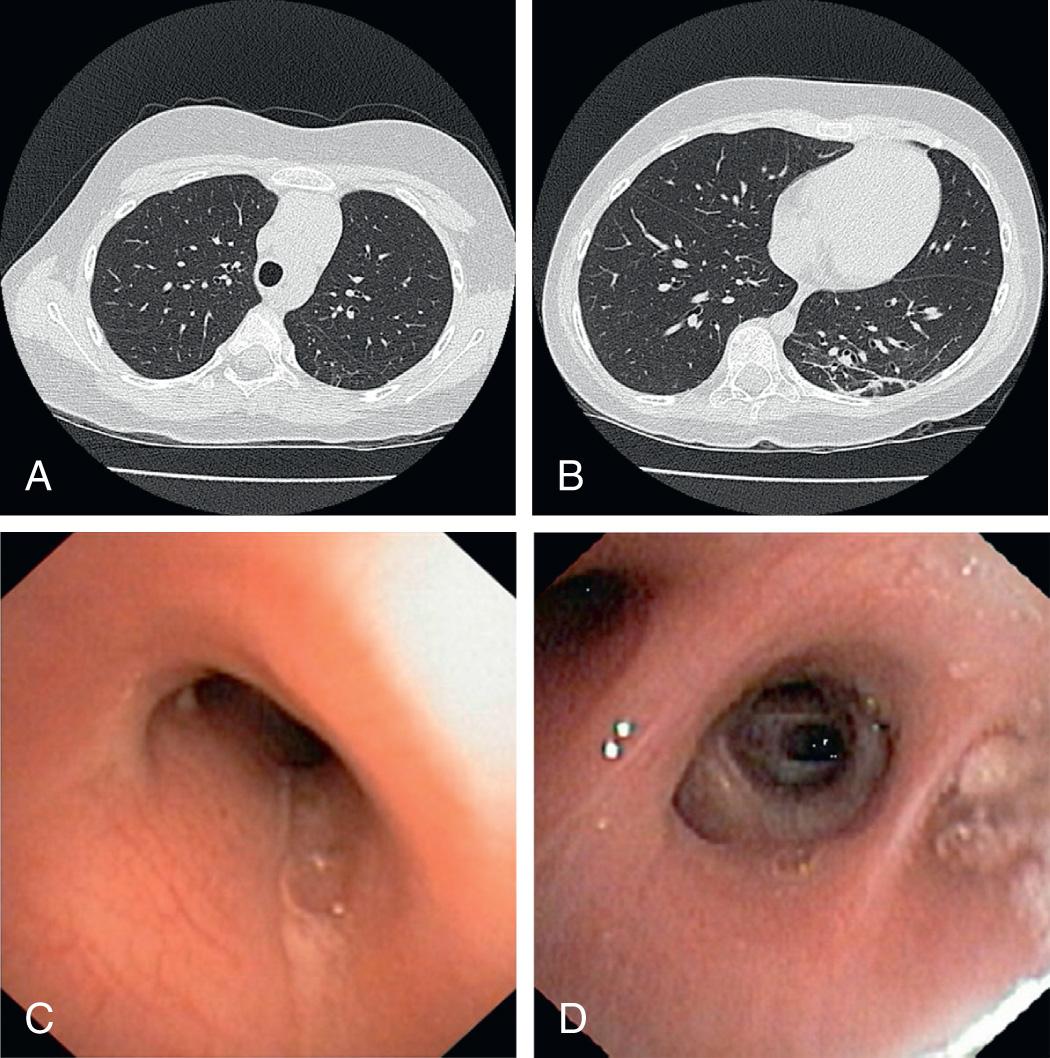Physical Address
304 North Cardinal St.
Dorchester Center, MA 02124
Bronchiectasis is characterized by irreversible abnormal dilation and anatomic distortion of the bronchial tree and represents the common end stage of many nonspecific and unrelated antecedent events. Its incidence has been decreasing overall in industrialized countries, but it persists as a problem in lower- and middle-income countries and among some ethnic groups in industrialized nations (particularly in aboriginal children). Females are afflicted more frequently than males.
In industrialized nations, cystic fibrosis (see Chapter 432 ) is the most common cause of clinically significant bronchiectasis. Other conditions associated with bronchiectasis include primary ciliary dyskinesia (see Chapter 433 ), foreign body aspiration (see Chapter 405 ), aspiration of gastric contents, immune deficiency syndromes (especially humoral immunity), and infection, especially pertussis, measles, and tuberculosis ( Table 430.1 ). Bronchiectasis can also be congenital, as in Williams-Campbell syndrome , in which there is an absence of annular bronchial cartilage, and Marnier-Kuhn syndrome (congenital tracheobronchomegaly), in which there is a connective tissue disorder. Other disease entities associated with bronchiectasis are yellow nail syndrome (pleural effusion, lymphedema, discolored nails) and right middle lobe syndrome . The right middle lobe syndrome is mostly associated with other generalized causes of bronchiectasis including asthma, cystic fibrosis, primary ciliary dyskinesia, severe pneumonia, aspiration pneumonia, foreign bodies, and immune deficient states. Early phases of the right middle lobe syndrome manifest as persistent or recurrent right middle lobe infiltrates (pneumonia). The right middle lobe syndrome may be classified as intrinsic or extrinsic obstructive (tumors, granulomas, lymphadenopathy) and nonobstructive (aspiration, asthma, cystic fibrosis).
| PROXIMAL AIRWAY NARROWING |
| Airway wall compression (i.e., vascular ring, adenopathy impinging on airways) |
| Airway intraluminal obstruction (e.g., inhaled foreign body, granulation tissue) |
| Airway stenosis and malacia |
| AIRWAY INJURY |
| Bronchiolitis obliterans (e.g., postviral, after lung transplantation) |
| Recurrent pneumonitis or pneumonia (e.g., pneumococcal pneumonia, aspiration pneumonia) |
| ALTERED PULMONARY HOST DEFENSES |
| Cystic fibrosis |
| Ciliary dyskinesia |
| Impaired cough (e.g., neuromuscular weakness conditions) |
| ALTERED IMMUNE STATES |
| Primary abnormalities (e.g., hypogammaglobulinemia, common variable immune deficiency) |
| Secondary abnormalities (e.g., HIV infection, immunosuppressive agents) |
| OTHER |
| Allergic bronchopulmonary aspergillosis |
| Plastic bronchitis |
| Right middle lobe syndrome |
Three basic mechanisms are involved in the pathogenesis of bronchiectasis. Obstruction can occur because of tumor, foreign body, impacted mucus because of poor mucociliary clearance, external compression, bronchial webs, and atresia. Infections caused by Bordetella pertussis , measles, rubella, togavirus, respiratory syncytial virus, adenovirus, and Mycobacterium tuberculosis induce chronic inflammation, progressive bronchial wall damage, and dilation. More recently, nontypeable Haemophilus influenzae seems to be a common cause of infection in adults and children with bronchiectasis. Streptococcus pneumoniae and Moraxella catarrhalis are more common in children with bronchiectasis than in adult patients. Chronic inflammation similarly contributes to the mechanism by which obstruction leads to bronchiectasis. Both inadequate and exaggerated/dysregulated immune responses may play a role in the development of bronchiectasis. Activation of Toll-like receptors results in the activation of nuclear factor κB and the release of proinflammatory cytokines interleukin (IL)-1β, IL-8, and tumor necrosis factor-α. IL-8 is a chemoattractant for neutrophils, which are the main inflammatory cell involved in the pathogenesis of bronchiectasis. Once activated, neutrophils produce neutrophil elastase and matrix metalloproteinases, MMP-8 and MMP-9. IL-6, IL-8, and tumor necrosis factor-α are elevated in the airways of patients with bronchiectasis. Eosinophils are also elevated in airways of indigenous children with bronchiectasis which promote neutrophil recruitment, goblet cell hyperplasia, and airway destruction. There is an increase in proinflammatory cytotoxic T lymphocytes in peripheral blood of children with bronchiectasis. The mechanism by which bronchiectasis occurs in congenital forms is likely related to abnormal cartilage formation. The common thread in the pathogenesis of bronchiectasis consists of difficulty clearing secretions and recurrent infections with a “vicious cycle” of infection and inflammation resulting in airway injury and remodeling ( Fig. 430.1 ). In early stages, bronchiectasis consists primarily of bronchiolar wall thickening and destruction of elastin resulting in bronchial dilatation. In later stages, the bronchial walls develop cartilage destruction with associated pulmonary artery/arteriole vascular remodeling, resulting in pulmonary hypertension.

Bronchiectasis can manifest in any combination of 3 pathologic forms, best defined by high-resolution CT (HRCT) scan ( Fig. 430.2 ). In cylindrical bronchiectasis, the bronchial outlines are regular, but there is diffuse dilation of the bronchial unit. The bronchial lumen ends abruptly because of mucous plugging. In varicose bronchiectasis, the degree of dilation is greater, and local constrictions cause an irregularity of outline resembling that of varicose veins. There may also be small sacculations. In saccular (cystic) bronchiectasis, bronchial dilation progresses and results in ballooning of bronchi that end in fluid- or mucus-filled sacs. This is the most severe form of bronchiectasis. Bronchiectasis lies within a disease spectrum of chronic pediatric suppurative lung disease. The following definitions have been proposed: prebronchiectasis (chronic or recurrent endobronchial infection with nonspecific HRCT changes; may be reversible); HRCT bronchiectasis (clinical symptoms with HRCT evidence of bronchial dilation; may persist, progress, or improve and resolve); established bronchiectasis (like the previous but with no resolution within 2 yr). Early diagnosis and aggressive therapy are important to prevent the development of established bronchiectasis.

Become a Clinical Tree membership for Full access and enjoy Unlimited articles
If you are a member. Log in here